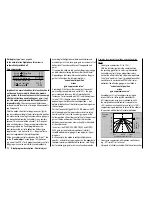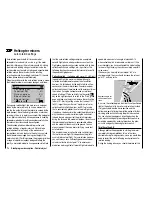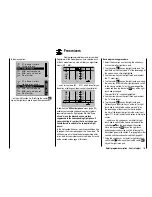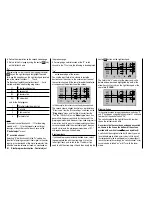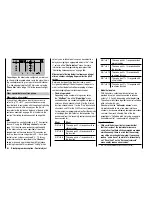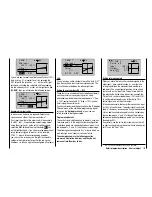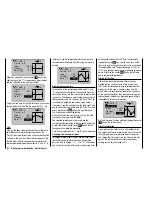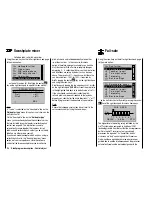
184
Detail program description - Control adjust
* N.N. = Nomen Nominandum (the name to be stated)
ty
fr
to
M1
M2
M3
6
11
M4
M5
??
??
??
??
??
??
P
??
??
Depending on the mixer value confi gured, a mixer can,
as shown in the example above, route the signal from a
fl ap control present (e.g.) on input 6 to control channel
11, while also applying the FLAP trim value set on the
"
Phase trim
" menu (page 136) for the respective fl ight
phase.
Other special features of free mixers
Mixer input = mixer output
If you set up a mixer whose input is the same as its
output, e.g. "C1
C1", you can achieve some very
special effects in conjunction with the option of switching
a free mixer on and off in any way you like. Typical
examples for this feature can be found at the end of this
section as example 2 on page 190, plus others in the
section "Controlling timed sequences" on page 266.
Tip:
If you separate a control function, e.g. "9", from control
channel 9" using the "
MIX-only channel
" menu (see
page 193), then the servo response is defi ned only
by the mixer ratio (yet to be specifi ed) of the mixer
programmed on the same channel. This enables you
to set up linear curves using mixers M1 … 8 or 6-point
control curves using curve mixers K9 … 12 for any
transmitter control, as described in the "
Channel 1
curve
" menu, and also include them in fl ight phase
switching if required. This method of "linking" is then
not only also switchable, but can even be subject to a
delay, by assigning an appropriate delay in the "– time
+" column of the "
Control adjust
" menu. For more
information, see the programming example entitled
"Controlling timed sequences" on page 266.
Mixer output affecting default software coupling of
aileron, camber-changing fl ap or collective pitch
servos
Before we start specifying the mixer ratio, we must
fi rst give some thought to what happens if we permit a
mixer to affect the default software coupling of aileron,
camber-changing fl ap or collective pitch servos:
Fixed-wing models:
•
Depending on the number of wing servos set on
the
"Aile/fl aps"
line of the
"Model type"
menu,
control channels are connected together via special
mixers as follows: channels 2 and 5 for the "Aileron"
function; channels 6 and 7 for the "Flap" function; and
channels 9 and 10 for the FLAP2 servos (if present).
If mixer outputs are programmed to affect these kinds
of couplings, then their effect on the respective fl ap
pair derived from the "receiving" control channel must
be accounted for:
Mixer
Effect
N.N.*
2
The servo pair 2 + 5 responds with an
aileron function
N.N.*
5
The servo pair 2 + 5 responds with a
fl ap function
N.N.*
6
The servo pair 6 + 7 responds with a
fl ap function
N.N.*
7
The servo pair 6 + 7 responds with an
aileron function
N.N.*
9
The servo pair 9 + 10 responds with a
fl ap function
N.N.*
10 The servo pair 9 + 10 responds with
an aileron function
N.N.*
11 The servo pair 11 + 12 responds with
a fl ap function
N.N.*
12 The servo pair 11 + 12 responds with
an aileron function
Model helicopters:
•
With heli mixers, collective pitch control may be
provided by up to 4 servos connected to receiver
outputs 1, 2, 3 and 5, depending on helicopter type.
The software links these together to control collective
pitch, roll and pitch-axis.
Elsewhere than the
"Helicopter mixers"
menu,
it is
not
advisable to mix a free mixer into these
channels, since some extremely complex interactions
can result from such attempts. One of the few
exceptions is "Collective pitch trim using a separate
transmitter control" – see example 3 on page 190.
Important notices:
With serial links in particular, remember that
•
that the travels of the individual mixers are
cumulative if multiple stick commands are made
simultaneously: there is a risk that the servo(s)
may strike a mechanical end-stop. If necessary,
reduce "servo travel" to avoid this; alternatively,
set "Travel limit" on the "Servo adjustments"
menu and/or reduce mixer values.
Summary of Contents for mx-20 Hott
Page 41: ...41 Your notes...
Page 49: ...49 Your notes...
Page 55: ...55 Your notes...
Page 81: ...81 Your notes...
Page 85: ...85 Your notes...
Page 89: ...89 Your notes...
Page 99: ...99 Detail program description Control adjust...
Page 127: ...127 Detail program description Control adjust...
Page 131: ...131 Detail program description Control adjust...
Page 163: ...163 Detail program description Control adjust...
Page 191: ...191 Detail program description Control adjust...
Page 207: ...207 Detail program description Control adjust...
Page 228: ...228 Detail program description Control adjust...
Page 229: ...229 Detail program description Control adjust...
Page 251: ...251 Detail program description Control adjust...



